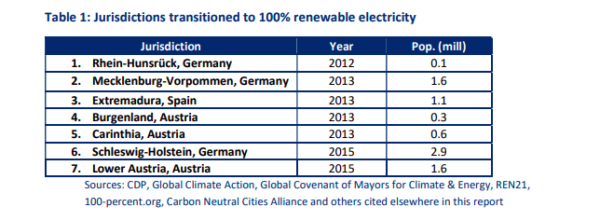Against the backdrop of a striking lack of action on climate at the federal level, Australia’s capital city is emerging among the world-leading jurisdictions which have transitioned to 100% renewable electricity.
A new report released by The Australia Institute (TAI) on Wednesday finds the Australian Capital Territory (ACT) is set to become the first major jurisdiction with a population of more than 100,000 outside Europe, and just the eighth globally to complete the transition away from a fossil-fuel based energy supply.
The ACT will switch to 100% renewable electricity when its offtake contract with Hornsdale Wind Farm in South Australia commences on October 1. According to TAI, the ACT will join just seven cities across Austria, Germany and Spain that have already completed this transition.

A further four jurisdictions in the Netherlands, Sweden, Norway and Uganda, are soon expected to join the group and reach the 100% renewable electricity targets within the next year. The report notes there are now over 107 countries, provinces and cities with 100% renewable electricity targets, with an average target year of 2033.
While there are some jurisdictions that have achieved 100% renewable energy based on historic investment in hydroelectricity, the ACT will join a select few to have made the transition from a fossil fuel-dominated energy system, the report notes.
To achieve its 100% renewable goal, the ACT government has implemented a number of progressive policies and mechanisms, including its reverse auction scheme which has paved the way to 640 MW of wind and solar across 10 large-scale projects and already leveraged more than $2 billion of investment around Australia, and more than $500 million in the ACT.
To be on the safe side, the territory announced last week a further reverse auction for up to 250 MW of new renewable energy generation and 20MW/40MWh of battery storage with the goal to maintain 100% renewable electricity into the future as its economy and population expand. Only days later, it unveiled the next phase of its strategy towards zero net emissions and pledged to phase out gas and pursue electrification of transport.
“The ACT is a renewable energy trailblazer. Achieving 100% renewable status shows what governments can achieve with strong climate and energy policy,” said Richie Merzian, Climate & Energy Program Director at TAI.
The TAI report is released in the week that has seen new turmoil in the energy arena. The Australian Competition and Consumer Commission has launched a new attack on Australia’s rooftop solar rebate and renewed its calls to prematurely wind down taxpayer-funded incentives for sub-100kW solar systems by 2021. Meanwhile, the Federal Government has introduced a revamped version of its ‘big stick’ energy policy to Parliament, which would give the government powers to potentially prevent big utilities from closing down ageing coal generators.
“This shows that states and territories are leading the way on climate action while national governments often lag behind. Australia is a perfect example,” Merzian said. “While some federal parliamentarians are trying to hit the brakes Australia’s energy transition, even Parliament House will soon run on 100% renewable energy.”
This content is protected by copyright and may not be reused. If you want to cooperate with us and would like to reuse some of our content, please contact: editors@pv-magazine.com.









By submitting this form you agree to pv magazine using your data for the purposes of publishing your comment.
Your personal data will only be disclosed or otherwise transmitted to third parties for the purposes of spam filtering or if this is necessary for technical maintenance of the website. Any other transfer to third parties will not take place unless this is justified on the basis of applicable data protection regulations or if pv magazine is legally obliged to do so.
You may revoke this consent at any time with effect for the future, in which case your personal data will be deleted immediately. Otherwise, your data will be deleted if pv magazine has processed your request or the purpose of data storage is fulfilled.
Further information on data privacy can be found in our Data Protection Policy.